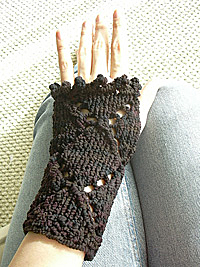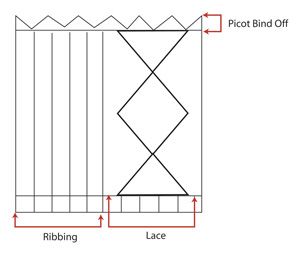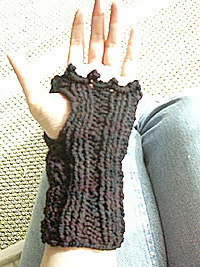Copyright Marnie MacLean 2003
Click on Images for Larger View
Gauge:
Ziti: 14 Stitches x 18 rows =4"
Supplies:
- #13 needles
- 1 ball of ziti in color of choice
- 2 Stitch markers
Yarn substitution
Ziti is a bulky weight yarn with a lot of stretch and a bit of it's own texture. It also has just a touch of metallic to it. You could hold about 3 strands of Cascade Fixation to get a similar hand, but I've seen these worked up in other bulky and aran yarns with great results.
Stitches used:
- 2 x 2 ribbing
- K
- P
- Knit 2 together (K2tog)
- Yarn over (YO)
- Slip (sl)
- Pass over (psso)
 Lace Pattern (worked over 11 stitches):
Lace Pattern (worked over 11 stitches):
Row 1: K1, yo, k2tog, k5, k2tog, yo, k1
Rows 2, 4, 6, 8, 10, 12, 14, 16: Purl
Row 3: K2, yo, k2tog, k3, k2tog, yo, k2
Row 5: K3, yo, k2tog, k1, k2tog, yo, k3
Row 7: K4, yo, sl 1, k2tog, psso, yo, k4
Row 9: K3, k2tog, yo, k1, yo, k2tog, k3
Row 11: K2, k2tog, yo, k3, yo, k2tog, k2
Row 13: K1, k2tog, yo, k5, yo, k2tog, k1
Row 15: K2tog, yo, k7, yo, k2tog
Picot Bind off:
BO 2
*CO 2, BO4* repeat to end
BO remaining St, cut yarn and pull through look to finish.
 Left Glove
Left Glove
CO 23
Work 3 rows of K2 P2 ribbing to end (there's an odd number of stitches so you'll have one extra which is fine)
You should now have the one odd stitch as your first stitch.
Place stitch markers between first and second stitch of this row, and after the 12th stitch. This marks the start and end of the lace panel for the front.
K1, Work row 1 of Lace pattern, continue with ribbing from previous rows to end.
Working in the manner of the previous row, knit until you have completed the entire 16 row lace pattern twice. See schematic for clarification.
Once you have completed the lace pattern twice, work Picot Bind off, cut tail and weave in.
 Right Glove
Right Glove
Worked as Left Glove with Lace and Ribbing panels in reversed locations.
Finishing
From picot edge, sew down 1" with invisible seam.
Leave 1.75" open then sew remaining seam to end.
One note on working with Ziti, it's a very sturdy yarn and is a pleasure to knit but be very careful when weaving in the ends that you do not split the yarn with your tapestry needle. This can cause the yarn to split and your work to unravel, which will make for a bad day. Try using a plastic tapestry needle which is less likely to pierce the yarn and more likely to simply push the yarn aside, which is what you really want to be doing.
Thank you so much for your interest in my patterns. Most of my free patterns were efforts to learn to design and do not conform to industry standards for sizing or terminology. Enough people continue to knit from these designs that I am happy to leave these patterns up for people to use but I cannot offer any amendments or substantial support for them.
As with all my patterns, you are welcome to use these patterns for your own personal, non-commercial or charitable use. If you wish to sell items made from these patterns or teach classes using my patterns, please contact me. Please do not distribute this pattern in print or electronically or post this pattern to your own site or publication. If you wish to share this pattern, please send the person a link to my site.

